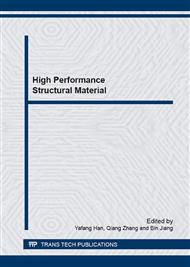p.15
p.21
p.27
p.33
p.40
p.48
p.54
p.64
p.71
Microstructure, Mechanical and Dielectric Properties of Si3N4-BN Composites with Different Porosities
Abstract:
Si3N4-BN composites were prepared by die-pressing and precursor infiltration and pyrolysis (PIP) route using borazine as the precursor. The composition, microstructure, mechanical, and dielectric properties of the composites with different porosities were investigated. With the adoption of starch as pore forming substance, drawn the Si3N4 preform from the liquid precursor borazine and decrease the pressure during curing, the porosity of the Si3N4-BN composites were effectively increased. Along with the increase of the porosity of the composites, the mechanical properties were decreased and the dielectric properties were improved. With 20 wt.% starch and drawn Si3N4 preform from borazine before curing, the density, porosity, flexural strength and elastic modulus of the composites were 1.70 g·cm-3, 29.78%, 48.05MPa and 32.45GPa, respectively. The dielectric constants and loss tangents were 4.20~4.44 and 0.48~3.42×10-3 at the frequency 7~ 18GHz. Composites with various dielectric and mechanical properties can be designed and prepared according to the application needs.
Info:
Periodical:
Pages:
40-47
Citation:
Online since:
April 2015
Authors:
Keywords:
Price:
Сopyright:
© 2015 Trans Tech Publications Ltd. All Rights Reserved
Share:
Citation:


